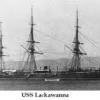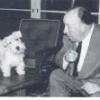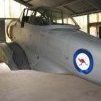MORE HANDBOOKS ARE ON THEIR WAY! We will let you know when they get here.
×
-
Posts
1,197 -
Joined
-
Last visited
Reputation Activity
-
 Stuntflyer reacted to michael mott in Greenwich Hospital barge of 1832 by druxey - FINISHED - 1:48 scale
Stuntflyer reacted to michael mott in Greenwich Hospital barge of 1832 by druxey - FINISHED - 1:48 scale
Druxey, such graceful lines and workmanship, you make it look so easy.
Michael
-
 Stuntflyer reacted to druxey in Greenwich Hospital barge of 1832 by druxey - FINISHED - 1:48 scale
Stuntflyer reacted to druxey in Greenwich Hospital barge of 1832 by druxey - FINISHED - 1:48 scale
Time for a progress report. The planking has slowly been spiled, cut, bent and hung as far as below the sheer strake. The first picture (arrowed) demonstrates the bevel for the land of the next strake. This was formed using the sanding stick mentioned earlier. Note that the bevel alters - and disappears - as the hull form changes.
The second photo shows the transition of the strakes at the stern from hooding into the stern post rabbet to running out over the tiny transom. Only two strakes end on the transom. Forming the junction of these two strakes neatly was tricky.
The last photograph shows off the elegance of the hull form. At this stage I bevelled the stem so that the planking appears to flow out of it. After the sheer strake is added there will be clean-up and minor adjustments to make.
-
 Stuntflyer reacted to Louie da fly in Greenwich Hospital barge of 1832 by druxey - FINISHED - 1:48 scale
Stuntflyer reacted to Louie da fly in Greenwich Hospital barge of 1832 by druxey - FINISHED - 1:48 scale
I'll give that some thought, Druxey. But as I see it, the extra work cutting the grooves might pay off in avoiding extra fiddling around trying to put the intermediate frames exactly in place.
The barge is certainly very lightly built. (In comparison, the keels of the Yenikapi galeai are 6" square and the frames vary between 50 and 60mm square (2'-2.4"). But they have a fairly comprehensive system of wales and stringers to prevent hogging).
I'm going to have to be careful to cut the planks exactly to prevent internal stresses as you mention above - this goes against my normal, rather slapdash approach to things (near enough is good enough). I think it's going to be quite an education in patience and precision for me.
But as mtaylor says - the shipwright is slow but the wood is patient . . .
Steven
-
 Stuntflyer reacted to michael mott in HM Cutter Cheerful 1806 by Engelmann - 1:48 - POB
Stuntflyer reacted to michael mott in HM Cutter Cheerful 1806 by Engelmann - 1:48 - POB
Dion, Yes a speedy recovery to your wife from me as well. the various skill sets that the members of this forum possess is amazing.
Michael
-
 Stuntflyer reacted to mtaylor in HM Cutter Cheerful 1806 by Engelmann - 1:48 - POB
Stuntflyer reacted to mtaylor in HM Cutter Cheerful 1806 by Engelmann - 1:48 - POB
Dion,
I too wish your wife a speedy recovery. No rush on your build from me. Family comes first.
-
 Stuntflyer reacted to Erik W in HM Cutter Cheerful 1806 by Erik W - 1:48 scale
Stuntflyer reacted to Erik W in HM Cutter Cheerful 1806 by Erik W - 1:48 scale
I cut out the forward gun ports for the bow chaser cannons. Before I did this, I thinned the wood material to about 3/16" using a rough sanding drum on a Dremel. This made cutting and filing the ports to shape easier since there was less material to cut through. I used a fine tooth solid Zona saw blade and some different shaped diamond files to get the gun ports cut and shaped correctly.
Erik
-
 Stuntflyer reacted to druxey in Greenwich Hospital barge of 1832 by druxey - FINISHED - 1:48 scale
Stuntflyer reacted to druxey in Greenwich Hospital barge of 1832 by druxey - FINISHED - 1:48 scale
Five strakes a side are completed now. Note that I had to pare back the extreme ends of the plug so that the planks would run smoothly into the rabbet fore and aft. With this hull form the spiled planks are only slightly curved, except at the stern.
-
 Stuntflyer reacted to druxey in Greenwich Hospital barge of 1832 by druxey - FINISHED - 1:48 scale
Stuntflyer reacted to druxey in Greenwich Hospital barge of 1832 by druxey - FINISHED - 1:48 scale
Thanks, everyone, for your comments.
Steven: I've used this method with carvel construction, but with one difference: frames first. You can either file grooves in the plug for the frames and bend them in, or form the plug to inside of frame. I use the first method. In both cases the plug is made deeper and extends above the sheer line. (You can see this set back area in shadow in the photograph.) This area is used to spot-glue the frames to. Just make sure everything is well waxed to prevent sticking! The boat looks a little rough when first taken off the plug, but cleans up nicely as you can see.
-
 Stuntflyer reacted to KenW in Rattlesnake by KenW - FINISHED - Model Shipways - Scale 1:64 - American Privateer
Stuntflyer reacted to KenW in Rattlesnake by KenW - FINISHED - Model Shipways - Scale 1:64 - American Privateer
All 20 guns are now installed. The boat looks good with them all lined up. One thing I noticed is that the four quoin handles I created this time are both smaller and better looking than those I made before. I guess I’m doing better; but I won’t be starting over. The work on the hull aft will not wait any longer; I have to get to it.
-
 Stuntflyer reacted to Erik W in HM Cutter Cheerful 1806 by Erik W - 1:48 scale
Stuntflyer reacted to Erik W in HM Cutter Cheerful 1806 by Erik W - 1:48 scale
I'm back in town, and back to work on the Cheerful. in the last couple of days I framed the gun ports. They still need to be faired. This proved to be a bit of a chore since each port has different sized lumber framing it. I used 1/4" square boxwood strip and cut/sanded it to shape. My fingers need a rest!
Erik
-
 Stuntflyer reacted to druxey in Greenwich Hospital barge of 1832 by druxey - FINISHED - 1:48 scale
Stuntflyer reacted to druxey in Greenwich Hospital barge of 1832 by druxey - FINISHED - 1:48 scale
The second strake is in on the port side. One can see the gain at the bow and stern, as well as how the boat keeps its shape when taken off the plug. From here on it is simply a matter of spiling and shaping each plank as I work up (down!) to the sheer strake. All one need do is make sure to conform to the mark-out on the plug.
-
 Stuntflyer reacted to druxey in Greenwich Hospital barge of 1832 by druxey - FINISHED - 1:48 scale
Stuntflyer reacted to druxey in Greenwich Hospital barge of 1832 by druxey - FINISHED - 1:48 scale
Here are a couple of photographs of the land - the bevel - being sanded on the edge of the garboard and of the gain at the end of the rabbet (arrowed). The gain is basically a rolling bevel. It ends at 45 degrees so that the next plank will come in flush at the rabbet. Essentially clinker becomes carvel over the last 9" or 12" of the strake.
-
 Stuntflyer reacted to michael mott in Greenwich Hospital barge of 1832 by druxey - FINISHED - 1:48 scale
Stuntflyer reacted to michael mott in Greenwich Hospital barge of 1832 by druxey - FINISHED - 1:48 scale
Having the sanding block the same width as the next strake is brilliant, I wish I had thought of that.
Michael
-
 Stuntflyer reacted to druxey in Greenwich Hospital barge of 1832 by druxey - FINISHED - 1:48 scale
Stuntflyer reacted to druxey in Greenwich Hospital barge of 1832 by druxey - FINISHED - 1:48 scale
A little more time was spent on completing the starboard garboard strake. The next step is to shape the lands for the second strake of planking. If one were to omit this step, the second strake would not have any gluing surface and there would be a gap under the strake, A. Obviously, a bevel is required. It varies in angle along the strake according to hull curvature, B. To cut this accurately, I took some scrap wood the width of a strake and rubber cemented some 220 grit sandpaper along one edge, C. Keeping the 'safe' corner of this along the mark-out of the second strake's far edge, it is easy to shape the correct bevel along the installed strake. The next instalment will show this completed.
A note: I found the short pins under the keel not very effective in holding the keel straight, as the keel kept popping off. On a another long narrow hull I would drill the pins all the way through the keel.
A digression: One side effect of modelling an open boat at this small scale is the amount of wood required to build it. Very little is needed, making this a very economic exercise in materials, but not in time.
-
 Stuntflyer got a reaction from mtaylor in Cutter Cheerful 1806 by Rustyj - FINISHED - 1:48 Scale
Stuntflyer got a reaction from mtaylor in Cutter Cheerful 1806 by Rustyj - FINISHED - 1:48 Scale
I like the tool you made for drawing the reference line.
-
 Stuntflyer got a reaction from Canute in Cutter Cheerful 1806 by Rustyj - FINISHED - 1:48 Scale
Stuntflyer got a reaction from Canute in Cutter Cheerful 1806 by Rustyj - FINISHED - 1:48 Scale
I like the tool you made for drawing the reference line.
-
 Stuntflyer got a reaction from Rustyj in Cutter Cheerful 1806 by Rustyj - FINISHED - 1:48 Scale
Stuntflyer got a reaction from Rustyj in Cutter Cheerful 1806 by Rustyj - FINISHED - 1:48 Scale
I like the tool you made for drawing the reference line.
-
 Stuntflyer reacted to Rustyj in Cutter Cheerful 1806 by Rustyj - FINISHED - 1:48 Scale
Stuntflyer reacted to Rustyj in Cutter Cheerful 1806 by Rustyj - FINISHED - 1:48 Scale
To start assembling the laser cut stern frames I first had to glue the two outer
frames for each side together. They were then placed in the corresponding slots
on the stern. Then three more frames were glued to these. In all 5 layers were
assembled on each side.
Here they are all glued and clamped to dry.
Once dry the laser char was removed. A reference line needed to be marked on
the frames. To do this I glued a piece of pencil lead to the end. Holding the strip
wood against the hull I traced the reference line. The wood will be removed so it
is close to the hull fairing.
-
 Stuntflyer reacted to druxey in Greenwich Hospital barge of 1832 by druxey - FINISHED - 1:48 scale
Stuntflyer reacted to druxey in Greenwich Hospital barge of 1832 by druxey - FINISHED - 1:48 scale
Further progress. The garboard is in on the port side and the forward plank on the starboard. The interesting thing is that, at any point in planking, provided one has spiled and shaped the plank to lie without stress, one can remove the model from the plug and it will retain its shape.
-
 Stuntflyer reacted to druxey in Greenwich Hospital barge of 1832 by druxey - FINISHED - 1:48 scale
Stuntflyer reacted to druxey in Greenwich Hospital barge of 1832 by druxey - FINISHED - 1:48 scale
Thank you, gentlemen all.
Finally had some quality time on the model. The first garboard plank is now spiled, cut, shaped and fitted. The stock is thin enough to cut with a sharp scalpel blade. The twist was achieved by cold wet bending and holding in place using rubber bands until dry. Castello takes more persuasion to bend than holly. Once the plank was dry, it was glued in place. I needed to cut back the plug more at the bow to allow the plank to land nicely in the bow rabbet.
One plank down, many more to go!
-
 Stuntflyer got a reaction from Martin W in Cutter Cheerful 1806 by rafine - FINISHED
Stuntflyer got a reaction from Martin W in Cutter Cheerful 1806 by rafine - FINISHED
A milestone for sure, Bob. It really does look great with all the deck fittings in place. Looking forward to your posts on rigging.
-
 Stuntflyer reacted to druxey in Greenwich Hospital barge of 1832 by druxey - FINISHED - 1:48 scale
Stuntflyer reacted to druxey in Greenwich Hospital barge of 1832 by druxey - FINISHED - 1:48 scale
Thanks for all the 'likes' and comments, everyone.
Dan: the planking butts are arranged to fall on the frames in the model. I'm not going as far as bevelled and clenched joints on 1/64" thick material! This is a 1:48 scale exercise. I may be mad, but not entirely crazy.
-
 Stuntflyer got a reaction from Captain Poison in HM Cutter Cheerful 1806 by Stuntflyer (Mike) - FINISHED - 1:48 scale
Stuntflyer got a reaction from Captain Poison in HM Cutter Cheerful 1806 by Stuntflyer (Mike) - FINISHED - 1:48 scale
I started lining off the deck today. . .
Using a tick strip, the deck beam reference line on the fore side of the main hatch was divided into equal segments. Mine needed eleven, each segment being slightly under 3/16". I divided the eleven spaces into two belts seven inner and four outer.
To establish the two belts down the length of the hull I decided to get the initial curve from the plan and adjust it later if needed on the deck itself. I had already made a copy of the plan sheet showing the deck. I made a few changes to the plan to correspond to the actual build. I placed a thin sheet of glass over the plan and used a ships curve and a fine line marking pen to draw the curve. Once I was satisfied with the run of the curve I placed 1/8" tape along the line directly to the glass.
A photo was taken and printed so the curve could be glued to card stock. Placing the curve on the deck showed that only a slight adjustment was needed at the location of the tick mark which divides the two belts. With the curve redrawn and a line transferred to both sides of the deck, I was ready to complete the remaining tick marks. Connecting the tick marks really helps to see what the run of planks will look like. In a few places I included the planks tab into the measurments and that was enough to throw off the even flow of planks down the hull. If I had not connected the tick marks it would have been very difficult to spot these errors.
Mike
-
 Stuntflyer got a reaction from PeteB in HM Cutter Cheerful 1806 by Stuntflyer (Mike) - FINISHED - 1:48 scale
Stuntflyer got a reaction from PeteB in HM Cutter Cheerful 1806 by Stuntflyer (Mike) - FINISHED - 1:48 scale
Planking the deck is not exactly what I would call a milestone though it does feel like I'm moving along. . .
Though not very scientific, I did come up with a way to get those center planks in a straight line. After setting the first plank at the stern I used a card template at each location along the deck to keep the planks straight. To confirm alignment, I marked the center of the plank at its forward edge as well as the aft edge of the deck structure. After pulling the plank to the card template I could see whether or not two marks matched closely
The four remaining planks (two on each side of center plank) where then installed using PVA and clamps. I was careful not to glue anywhere close to the red deck structures. Scrap strips were used between the clamp and the deck planking to avoid any dents that might be caused from tightening of the clamps. I don't have any of those high-tech wooden clamps like those used by EdT though the ones from Dewalt (found at Home Depot) worked well enough. The clamp's protective covers were removed in order to get a better grip on the planks. The Irwin Quick-Grips have a more rounded shape underneath the covers and tend to slip off too easily.
My deck planks are approximately 3/16" wide and in various locations will have a small tab. These have to be made using a wider strip. I tried making one that would have been 7/32" at its widest point using a 7/32" strip. Guess what, it didn't work. There wasn't enough room to allow for adjustments to the shape. I decided to go with a 1/4" strip, which worked quite well. Once the shape was completed it was only a matter of reducing the width to 3/16" outside of the tab location. This is an important step if you want to maintain consistency to the overall look of the planking.
This is the plank which goes on either side of the "ventilation scuttle grating", just behind the skylight.
Once the first five rows were completed, excess glue was removed and the planks were lightly sanded. I will hold off doing the final sanding until all of the remaining planks are in.
-
 Stuntflyer reacted to Erik W in 18th Century Longboat by BobF - FINISHED - Model Shipways - 1:48 - Tri-Club
Stuntflyer reacted to Erik W in 18th Century Longboat by BobF - FINISHED - Model Shipways - 1:48 - Tri-Club
Bob,
Long build time = getting your money's worth!
Erik








